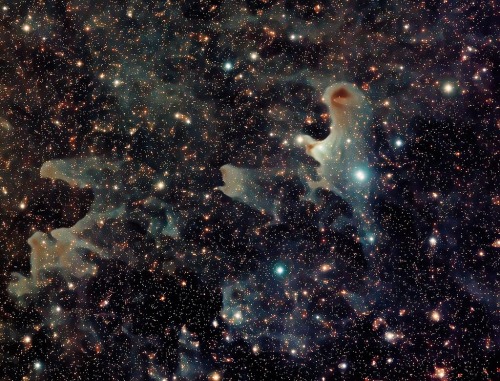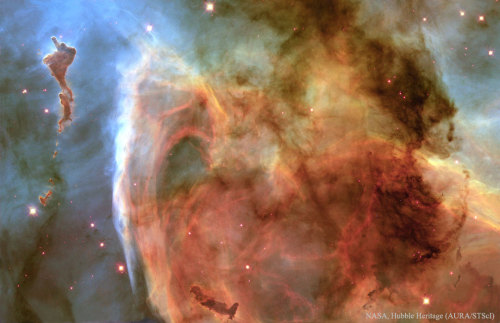VdB 141 Region Nebulosity By Jeffrey Weiss On Flickr.

VdB 141 Region Nebulosity by Jeffrey Weiss on Flickr.
More Posts from Littlecadet-biguniverse and Others
Do telescopes actually take colorful photographs or are the pretty colorful photographs of galaxies that we know colored afterwards? If a human was floating through space, would space look colorful to them?
So some pictures are taken in different wavelengths to see different characteristics. (infrared wavelengths to see through thick gas and dust, xray wavelengths to see highly energized regions)
But, in the visible wavelengths you are seeing the colors. They’re just enhanced brighter than they might be.
For example, I took this picture of “the California Nebula” using a camera (Canon 60Da) attached to a telescope. This shows one exposure, and the background is red due to effects of the camera (which you subtract):

You take multiple exposures, combine them, subtract the background effects & adjust the color a little and get this…


Night Sky Over Mt. Fuji - Jan. 2016
js

The giant star Zeta Ophiuchi

Keyhole Nebula, inside the larger Carina Nebula

A ‘matryoshka’ in the interstellar medium
As if it were one of the known Russian dolls, a group of astronomers, led by researchers at the Instituto de Astrofísica de Canarias, (IAC) has found the first known case of three supernova remnants one inside the other. Using the programme BUBBLY, a method developed within the group for detecting huge expanding bubbles of gas in interstellar space, they were observing the galaxy M33 in our Local Group of galaxies and found example of a triple-bubble. The results, which were published yesterday in the journal Monthly Notices of the Royal Astronomical Society, help to understand the feedback phenomenon, a fundamental process of star formation and in the dissemination of metals produced in massive stars.
The group has been building up a data base of these superbubbles with observations of a number of galaxies and, using the very high resolution 2D spectrograph, GHaFaS (Galaxy Halpha Fabry-Perot System), on the 4.2 m William Herschel Telescope (WHT) of the Isaac Newton Group of Telescopes (Roque de los Muchachos Observatory, La Palma), has been able to detect and measure these superbubbles, which range in size from a few light years to as big as a thousand light years across.
Superbubbles around large young star clusters are known to have a complex structure due to the effects of powerful stellar winds and supernova explosions of individual stars, whose separate bubbles may end up merging into a superbubble, but this is the first time that they, or any other observers, have found three concentric expanding supernova shells.
“This phenomenon -says John Beckman, one of the co-authors on the paper- allows to explore the interstellar medium in a unique way, we can measure how much matter there is in a shell, approximately a couple of hundred times the mass of the sun in each of the shells”. However, if it is known that a supernova expels only around ten times the mass of the sun, where do the second and third shells get their gas from if the first supernova sweeps up all the gas?
The answer to that must come from the surrounding gas and in the inhomogeneous interstellar medium. “It must be -says Artemi Camps Fariña, who is first author on the paper-, that the interstellar medium is not at all uniform, there must be dense clumps of gas, surrounded by space with gas at a much lower density. A supernova does not just sweep up gas, it evaporates the outsides of the clumps, leaving some dense gas behind which can make the second and the third shells”.
“The presence of the bubbles -adds Artemi- explains why star formation has been much slower than simple models of galaxy evolution predicted. These bubbles are part of a widespread feedback process in galaxy disc and if it were not for feedback, spiral galaxies would have very short lives, and our own existence would be improbable”, concludes. The idea of an inhomogeneous interstellar medium is not new, but the triple bubble gives a much clearer and quantitative view of the structure and the feedback process. The results will help theorists working on feedback to a better understanding of how this process works in all galaxy discs.

“Rho Ophiuchi Cloud Complex Area Of The Milky Way” by Martin Campbell on Flickr.

NASA Astronomy Picture of the Day 2016 August 31
Annular Solar Eclipse over New Mexico
What is this person doing? In 2012 an annular eclipse of the Sun was visible over a narrow path that crossed the northern Pacific Ocean and several western US states. In an annular solar eclipse, the Moon is too far from the Earth to block out the entire Sun, leaving the Sun peeking out over the Moon’s disk in a ring of fire. To capture this unusual solar event, an industrious photographer drove from Arizona to New Mexico to find just the right vista. After setting up and just as the eclipsed Sun was setting over a ridge about 0.5 kilometers away, a person unknowingly walked right into the shot. Although grateful for the unexpected human element, the photographer never learned the identity of the silhouetted interloper. It appears likely, though, that the person is holding a circular device that would enable them to get their own view of the eclipse. The shot was taken at sunset on 2012 May 20 at 7:36 pm local time from a park near Albuquerque, New Mexico, USA. Tomorrow another annular solar eclipse will become visible, this time along a path crossing Africa and Madagascar.
What is the difference between a supernova and a hypernova?
That’s a really good question, and the simple answer is that a hypernova produces way more energy than a standard supernova. Supernovae are known as being bright explosions from massive stars, and their remnant is usually a neutron star.

Hypernovae, however, more commonly produce black holes due to being from stars more massive than those that cause supernovae. Often time, they appear brighter too, which is why an alternate name for hypernovae is “superluminous supernovae”. Hypernovae are sometimes also the cause of gamma-ray bursts, a dangerous release of energy so high that it will fry anything in its path.

Thanks for asking! :)
Another Station Upgrade:
Spacewalkers Jeff Williams and Kate Rubins to install new TV cameras
On Thursday, Sept. 1, U.S. astronauts Jeff Williams and Kate Rubins will conduct the station’s 195th American spacewalk. As part of their activities, the pair will install the first of several enhanced high-definition television cameras that will monitor activities outside the station, including the comings and goings of visiting cargo and crew vehicles

Working on the station’s backbone, or truss, Williams and Rubins will retract a thermal radiator that is part of the station’s cooling system.

As was the case for their first spacewalk together on Aug. 19, Williams will be designated as extravehicular crew member 1 (EV1), wearing a spacesuit with a red stripe, while Rubins will be EV2, wearing a suit with no stripes.
Watch LIVE!
Coverage of the spacewalk begins at 6:30 a.m. EDT on Thursday, Sept. 1; with the spacewalk scheduled to begin at 8:05 a.m. EDT. Stream live online HERE.
Make sure to follow us on Tumblr for your regular dose of space: http://nasa.tumblr.com
-
 maziique-archived reblogged this · 2 years ago
maziique-archived reblogged this · 2 years ago -
 maziique-archived liked this · 2 years ago
maziique-archived liked this · 2 years ago -
 ambrysia liked this · 4 years ago
ambrysia liked this · 4 years ago -
 masarawat liked this · 4 years ago
masarawat liked this · 4 years ago -
 colorandtheshape liked this · 4 years ago
colorandtheshape liked this · 4 years ago -
 out-one liked this · 4 years ago
out-one liked this · 4 years ago -
 intergalacticactivity reblogged this · 4 years ago
intergalacticactivity reblogged this · 4 years ago -
 dreamyreadingnerd liked this · 5 years ago
dreamyreadingnerd liked this · 5 years ago -
 carriefishers reblogged this · 5 years ago
carriefishers reblogged this · 5 years ago -
 pallor-mortis-symptoms reblogged this · 6 years ago
pallor-mortis-symptoms reblogged this · 6 years ago -
 sailingonthewaves liked this · 6 years ago
sailingonthewaves liked this · 6 years ago -
 imjustamonster reblogged this · 6 years ago
imjustamonster reblogged this · 6 years ago -
 astral-22 liked this · 6 years ago
astral-22 liked this · 6 years ago -
 paulgirardschmidt liked this · 6 years ago
paulgirardschmidt liked this · 6 years ago -
 taylorbourkexo reblogged this · 7 years ago
taylorbourkexo reblogged this · 7 years ago -
 holdfastlesley reblogged this · 7 years ago
holdfastlesley reblogged this · 7 years ago -
 livinginsadness reblogged this · 7 years ago
livinginsadness reblogged this · 7 years ago -
 earth-and-space reblogged this · 7 years ago
earth-and-space reblogged this · 7 years ago -
 earth-and-space liked this · 7 years ago
earth-and-space liked this · 7 years ago -
 gimihmusqilee-blog liked this · 7 years ago
gimihmusqilee-blog liked this · 7 years ago -
 whooliganshenanigans reblogged this · 7 years ago
whooliganshenanigans reblogged this · 7 years ago -
 gestirne reblogged this · 7 years ago
gestirne reblogged this · 7 years ago -
 flame-shadow reblogged this · 7 years ago
flame-shadow reblogged this · 7 years ago -
 theremharths reblogged this · 7 years ago
theremharths reblogged this · 7 years ago -
 iputpeopleinpies reblogged this · 7 years ago
iputpeopleinpies reblogged this · 7 years ago -
 are-u-an-appliance liked this · 7 years ago
are-u-an-appliance liked this · 7 years ago -
 androgynousfrog reblogged this · 7 years ago
androgynousfrog reblogged this · 7 years ago -
 theunexpectedfifth reblogged this · 7 years ago
theunexpectedfifth reblogged this · 7 years ago -
 emony-dax reblogged this · 7 years ago
emony-dax reblogged this · 7 years ago -
 24hourbug-blog liked this · 7 years ago
24hourbug-blog liked this · 7 years ago -
 ipeachesandpeoniesi-blog liked this · 7 years ago
ipeachesandpeoniesi-blog liked this · 7 years ago -
 stegamorris-blog reblogged this · 8 years ago
stegamorris-blog reblogged this · 8 years ago -
 that-demon-named-dustin liked this · 8 years ago
that-demon-named-dustin liked this · 8 years ago -
 ancientmoderntimes liked this · 8 years ago
ancientmoderntimes liked this · 8 years ago -
 mlo7wtr liked this · 8 years ago
mlo7wtr liked this · 8 years ago -
 avara-avara liked this · 8 years ago
avara-avara liked this · 8 years ago
GREETINGS FROM EARTH! Welcome to my space blog! Let's explore the stars together!!!
144 posts